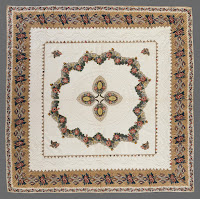 |
| Rosina Machette 1840 |
American Colonial Quilts
The colonial history of the United States covers the period of European colonization of North America from the early 16th century until the uniting of the Thirteen English Colonies and creation of the United States in 1776, during the Revolutionary War.
Whole Cloth Quilts
In American Colonial times, quilts were predominantly whole-cloth quilts - a single piece of fabric layered with batting and backing held together with fine needlework quilting.
Appliqué Quilts
"Dresden Plate" and "Sunbonnet Sue" are two examples of traditional American quilt blocks that are constructed with both patchwork and appliqué.
Baltimore album ilts originated in Baltimore, Maryland, in the 1840s. They have become one of the most popular styles of quilts and are still made today. These quilts are made up of a number of blocks appliquéd with a different design.
 |
| Baltimore Album 1848 |
The designs are often floral, but many other motifs are also used, such as eagles and landmarks. They have a background of white and incorporate many primary colors such as reds, greens and blues.
Broderie Perse Quilts
Broderie perse quilts were popular during this time and the majority of pierced or appliqued quilts made during the 1770–1800 period were medallion-style quilts (quilts with a central ornamental panel and one or more borders).
 |
| Broderie Perse 1846. |
Broderie perse (French for "Persian embroidery") is a style of appliqué which uses printed motifs from one fabric to create a design on a background fabric. It was popular in the late 18th century and early 19th centuries.
Patchwork Quilts
Patchwork quilting in America dates to the 1770s, the decade the United States gained its independence from England. These late-eighteenth- and nineteenth-century patchwork quilts often mixed wool, silk, linen, and cotton in the same piece, as well as mixing large-scale (often chintz) and small-scale (often calico) patterns.
In North America, some worn-out blankets were utilized to create a new quilt from worn-out clothes, and in these quilts the internal batting layer was made up of old blankets or older quilts.
Foundation Piecing
During American pioneer days, foundation piecing became popular. Paper was cut into shapes and used as a pattern; each individual piece of cut fabric was basted around the paper pattern.
Paper was a scarce commodity in the early American west so women would save letters from home, postcards, newspaper clippings, and catalogs to use as patterns. The paper not only served as a pattern but as an insulator. Paper found between these old quilts has become a primary source of information about pioneer life.
Resources

No comments:
Post a Comment